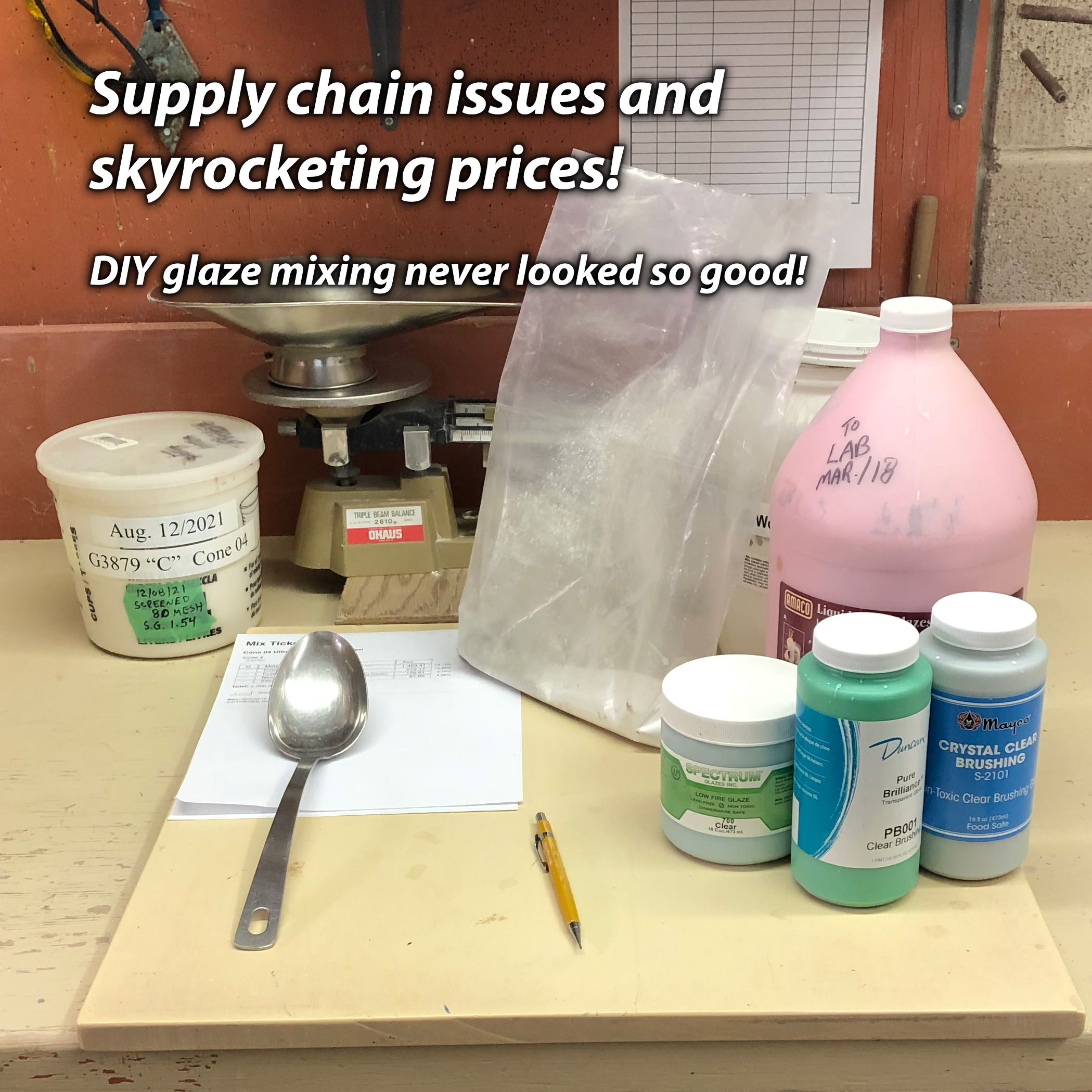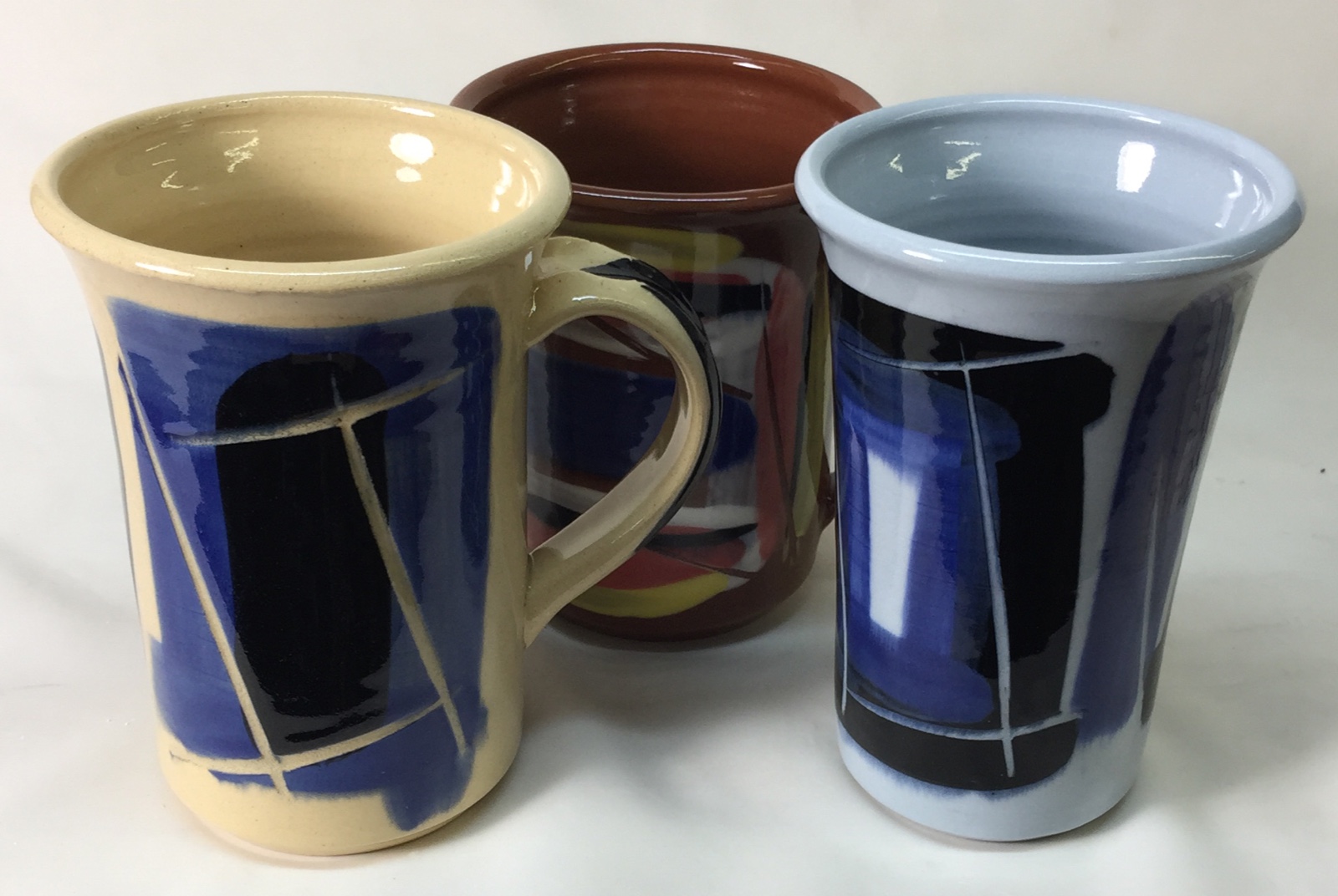| Monthly Tech-Tip | No tracking! No ads! | |
Insight-Live Shares (also referencing this recipe)
These add technical detail, development info, variations and improvements.
G3879 - Cone 04+ UltraClear Glossy Base
Modified: 2025-04-06 20:40:46
A super transparent low fire base clear glaze created by reverse engineering a commercial product.
| Material | Amount | Percent |
|---|---|---|
| Fusion Frit F-524 | 850.00 | 82.9 |
| Fusion Frit F-69 | 40.00 | 3.9 |
| EPK | 90.00 | 8.8 |
| Silica | 45.00 | 4.4 |
| 1,025.00 | 100 | |
Notes
We developed this for cone 06-04 to fit many clay bodies (without crazing), melt well at cone 05 and produce a more transparent glaze (rather than the amber of G2931K and G1916Q). The frit F-524 in this recipe is uncommon among potters but common in industry, it is high quality. We later adjusted this recipe to produce variations (e.g. with whiter kaolin, more of the frit F-69 to get a lower thermal expansion).
We found the inspiration for this on testing many commercial clears and finding one that stood above the others regarding fit and clarity at 04 (we had it analyzed and reverse-engineered it using the materials we have). Frit F-524 is expensive, but this glaze is heads-above a number of commercial clear glazes we have tested (they are not ultra-clear, they pinhole or blister or craze, they are not glossy enough, they do not have dipping versions, they are not adjustable). The F-69 is also expensive, but it enables fitting this to any body.
Additions of tin and zircon produce a white that melts just as well as the clear. To make bright-colored glazes this should be an excellent base (remember, this is the clear glaze recipe currently used by at least one commercial supplier of bright-colored glazes). Encapsulated stains are fantastic at low fire and they can be mixed to fine-tune the color. If you are targeting a specific or exotic color then the ability to achieve it will be determined by your ability to source an exotic stain!
The melt is very mobile at 04 yet not significantly more mobile at cone 1 (even up to cone 2). And it has the amount of SiO2 and Al2O3 that a cone 6 glaze has yet melts well at 06! There is some kind of magic with this chemistry!
It hardens to a powdery surface, some gum solution is required to make it dry hard for dipping (for each 100g of powder mix start with 73g water and 7g Laguna gum solution). To make a brushing glaze: For each 100g of powder mix start with 125 water, 1.5 CMC gum and 1.5 Veegum and blender mix (add water if it gels too much). We find the about 330g of powder produces a 500ml (about 1 pint) jar.
This recipe also has implied adjustability (by increasing the low expansion Frit F-69 at the expense of Frit F-524).
Related Information
How to reverse-engineer a commercial transparent glaze

This picture has its own page with more detail, click here to see it.
The commercial cone 04 clear brushing glaze (on the left) works really well on our clay bodies so I sent it away to be analyzed (about $130). That revealed high Al2O3/SiO2 levels, this explains its resistance to crazing on our clay bodies and, even better, indicates high durability. In my account at insight-live.com I was able source the same chemistry from two Fusion frits (plus a little kaolin and silica). The melt fluidities are almost identical (my G3879 has a little more surface tension). I needed to make a dipping glaze version and chose a method that would produce a thixotropic slurry. One caution: An assay lab cannot analyze the complexities of a colored glaze, instead focus on the base clear and add stains to that. The first two-gallon bucket made saved the development cost plus more! And knowing the recipe made it possible to adjust for even lower thermal expansion. Another plus: I can now make my own low SG or high SG brushing version.
SIAL 10F and 25F with G3879 clear glaze at cone 04

This picture has its own page with more detail, click here to see it.
SIAL bodies are made in Montreal, Canada. The glaze was applied by dipping. The fit is still holding on both bodies after many months.
How to stop low fire clays from waterlogging

This picture has its own page with more detail, click here to see it.
Being fired at cone 04, this talc body is quite porous. Water is entering through the unglazed base. During an overnight immersion it penetrated upward to about 1 cm from the rim (and even travelled two-thirds of the way up the handle). So, is this clay and temperature practical for functional ware? Yes. The base can be glazed or siliconed, completely stopping water entry. Heating this in the microwave for an extended period did not fracture it. And even though the mug got incredibly hot the G3879 glaze did not craze - that gives reasonable assurance it will hold up over time. Low-fire bodies have plenty of advantages and they are certainly practical for functional use. Additionally, handmade items deserve common sense care during use (e.g. not leaving pieces in water for extended periods, even hand washing).
Casting Zero3 Porcelain

This picture has its own page with more detail, click here to see it.
Look at how translucent this is! I can fire one of these in three hours, cold-to-cold. I am casting them with molds made using the 3D-printing process. Anyone could do this. Incredibly exciting. And with the G3879 glaze it looks awesome, just like bone china. Notwithstanding this, the Zero3 recipe has to be altered for casting. Initially I have reduced the VeeGum to 1% but it is still casting too slow. And it is not shrinking enough to pull away from the mold well. I am considering strategies on how to increase drying shrinkage and am going to add more frit to take it down to cone 04.
Low fire glaze with the Al2O3 and SiO2 of a cone 6 glaze

This picture has its own page with more detail, click here to see it.
Look at how fluid G3879 is at cone 06 even though it has the Al2O3 and SiO2 of a cone 6 (or even cone 10 glaze)! It have found that glazes with lots of boron can tolerate amazingly high levels of Al2O3 and SiO2 and still melt very well. And they create many options to lower thermal expansion that would not otherwise be available. The G3806N recipe has the amazing ability to tolerate large additions of kaolin. Each addition sacrifices some melt fluidity but the glaze stays glossy and gets more durable (because of the increased Al2O3 and SiO2). And the thermal expansion drops even more. A highly melt fluid, super gloss with low thermal expansion is super difficult at cone 6, but here it is. The secret is high boron. From frits.
Why do these cone 04 and 6 clear glazes have so similar a chemistry?

This picture has its own page with more detail, click here to see it.
The glaze on the left (as shown in my account at insight-live.com) is a crystal clear at cone 04. The high frit content minimizes micro-bubbles. The high B2O3 melts it very well (this has 0.66 B2O3, that is three times as high as a typical cone 6 glaze). The recipe on the right is the product of a project to develop a low-thermal-expansion fluid-melt transparent for cone 6 (with added colorants fluid melts produce brilliant and even metallic results and they variegate well). While the balance of fluxes (the red numbers in the formula) is pretty different, look how similar the B2O3, Al2O3 and SiO2 levels are (yellow, red and blue backgrounded numbers in the formula), these mainly determine the melting range. That means that a fluid-melt cone 6 glaze may actually be just a low temperature glaze being overfired to cone 6.
When Supply Chains Broke, Prices Soared.
We haven’t forgotten. Time for DIY!

This picture has its own page with more detail, click here to see it.
Material prices were sky rocketing (and still are). Prepared glaze manufacturers have complex international supply chains. Now might be the time to start learning how to weigh out the ingredients to make your own. Armed with good base glazes that fit your clay body (without crazing or shivering) you will be more resilient to supply issues. Add stains, opacifiers and variegators to the bases to make anything you want. That being said, ingredients in those recipes may become unavailable! That underscores a need to go to the next step and "understand" glaze ingredients. And even improve and adjust recipes. It is not rocket science, it is just work accompanied by organized record-keeping and good labeling.
Low fire heaven: Use commercial underglazes but make your own clear over glaze

This picture has its own page with more detail, click here to see it.
Decorate ware with the underglazes at the leather hard stage, dry and bisque fire it and then dip-glaze in a transparent that you make yourself (and thus control). These mugs are fired at cone 03. All have the same transparent glaze (G2931K), all were decorated with the same underglazes. Notice how bright the colors are compared to middle or high temperature. On the left is a porous talc/stoneware blend (Plainsman L212), rear is a fritted Zero3 stoneware and right is Zero3 fritted porcelain. When mixed properly you can dip ware in this glaze and it covers evenly, does not drip and dries enough to handle in seconds! Follow the Zero3 firing schedule and you will have ware of amazing quality.
Links
| Glossary |
Zero3
The designation for a group recipes for body, glaze and engobe (by Tony Hansen), that potters can use to make low fire stoneware and fritware porcelain at 1100C (2000F) or cone 03. |
| Glossary |
Base Glaze
Understand your a glaze and learn how to adjust and improve it. Build others from that. We have bases for low, medium and high fire. |
XML to Paste Into Desktop Insight
<recipes>XML not functional: We are working on this problem.</recipes>
| By Tony Hansen Follow me on        |  |
Got a Question?
Buy me a coffee and we can talk

https://digitalfire.com, All Rights Reserved
Privacy Policy
